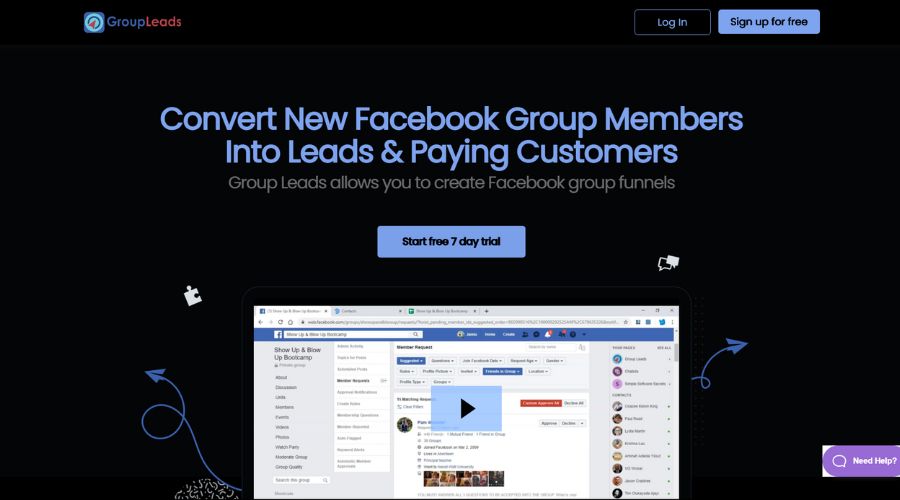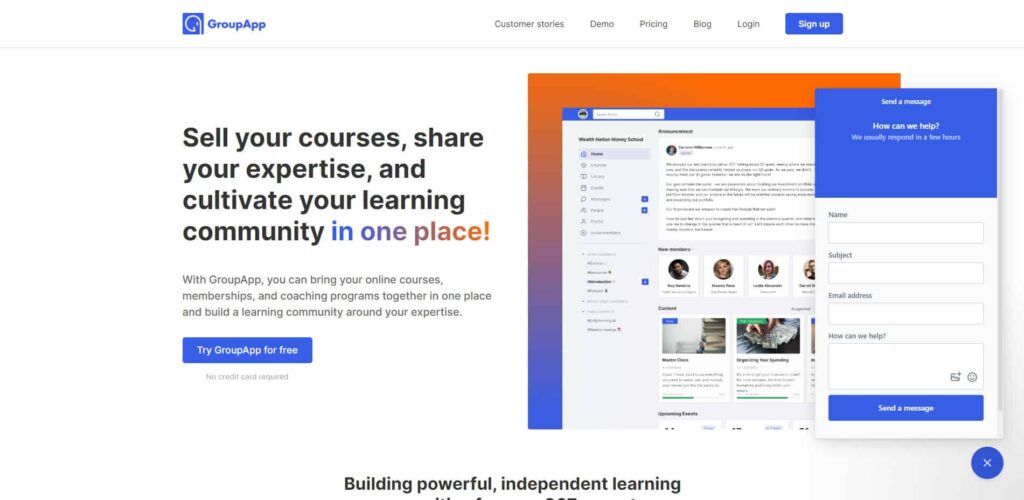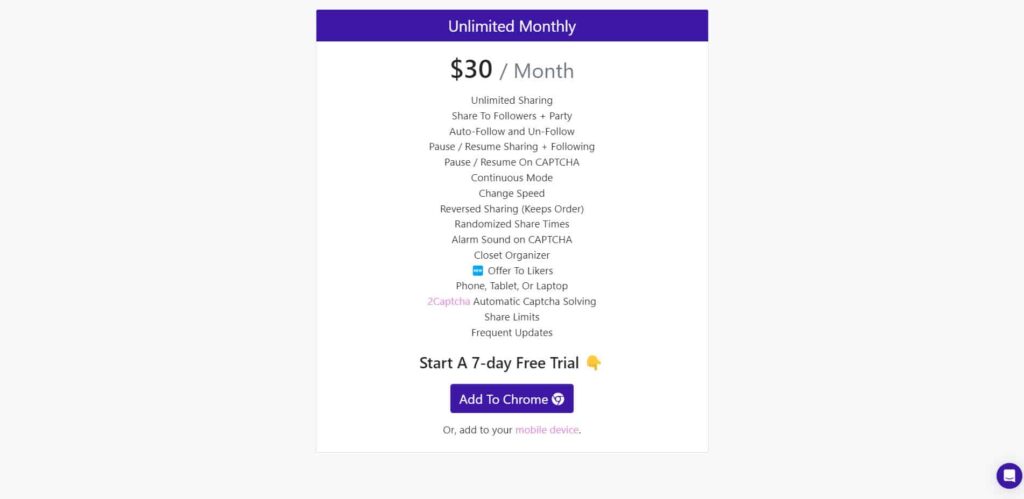Why is SaaS marketing different from traditional marketing? And why is it a better strategy for micro-SaaS founders?
Well, the answer is simple:
SaaS and micro-SaaS require a unique approach to appeal to potential users.
After all, you can’t sell micro-SaaS software the same way you would a physical product or service.
If you suffer from low customer acquisition, poor conversion, and high churn rates, staying on top of your SaaS marketing is critical.
In this post, you’ll learn the differences between traditional and SaaS marketing and also find solutions to help you succeed in the digital world.
Let’s begin.
Reason #1: The Digital Nature of Micro-SaaS

SaaS and micro-SaaS marketing strategies should take into account how fast the sales cycle is.
Because micro-SaaS solutions are digital, users can use the service in just a few minutes.
For example, people can use GroupLeads to convert new Facebook group members into leads and paying customers almost immediately after signing up.
At the same time, they can unsubscribe from the service whenever they want.
That’s why traditional marketing strategies won’t work.
You need a marketing strategy that’ll allow you to respond to customers’ issues and concerns quickly.
You also want marketing teams to acquire as many users as quickly as possible.
To this end, learning marketing strategies on top of SEO and content marketing techniques will go a long way.
Customer acquisition
Acquisition refers to making your product more well-known and engaging to potential customers.
Think of it as generating leads for your micro-SaaS company.
You want to hook people in by showing features that can help them achieve their goals.
With organic inbound marketing, it’s possible to get people to your site.
For example, you’ll need a strong landing page where users can see everything they need to know about your software.
Once you have this, give visitors a reason to leave their contact details, like their email addresses. Use them to send invitations or special offers.
As soon as you’ve acquired enough customers, you can shift your focus to converting each one.
Conversion

You can define conversion as having leads perform a specific action that contributes to your business goals.
In a regular eCommerce business, it’s the process of having a user buy the product.
But with SaaS and micro-SaaS companies, it’s a bit more complicated than that.
To be specific, conversion for micro-SaaS means either having a user sign up for a free trial (just like Dux-Soup’s 14-day trial) or having someone subscribe to its paid version.
Or, it could also mean convincing a user to upgrade if you implement a freemium model for your micro-SaaS pricing.
Because there could be more than one customer acquisition strategy, you’ll have to define what conversion means according to your goals.
Knowing your conversion rate will let you know if your overall marketing strategy is working or not.
If you don’t think you’re converting as much as you’d like, look into updating your approach.
Retention
Lastly, retention. It concerns making your existing customers happy.
Remember that you’re selling software as a service.
That means it’s an ongoing commitment.
In fact, many SaaS companies prioritize customer retention, as their future recurring revenue depends on it.
So, if you want to keep your customers, just make sure they stay happy.
You can start by listening to their feedback. Make sure that they feel heard.
And since you already have their email addresses, try sending them newsletters as well that highlight upcoming platform changes.
Having a customer service team that can help them should they run into issues is also a good idea.
We’ll dive more into retention details in the next section.
Reason #2: Length of Customer Relationships
Another thing that makes SaaS marketing different from traditional marketing is that its main focus is customer retention.
Unlike eCommerce businesses, software subscriptions are recurring transactions.
This means that you’re in it for the long haul, so you have to take care of your existing customers to ensure they stay.
And to do that, you need to…
1. Maintain a fantastic service
A SaaS marketer can get more people to stay on a platform by advertising its fantastic service.
Look for features your audience would love and make your marketing team focus on these.
You’d have more satisfied customers if you could provide and maintain this level of commitment to their needs.
Having loyal customers will also lead to more referrals and organic traffic.
Not only that, but keeping the quality of your service consistent helps save marketing dollars too.
After all, customer retention is a more affordable strategy compared to customer acquisition.
Apart from that, another benefit of maintaining a fantastic service is that you can upsell.
This is because it’s easier to upsell a higher plan to customers if the current offering is worth the investment.
2. Provide exceptional customer support

One thing you have to know is that the sales process doesn’t just stop at payment processing.
SaaS customers fully expect businesses to provide support as well should something go wrong.
The good thing is that there are many ways to go about it.
The most common is putting up a number that current customers can call if they have questions. For this, some tools can help you manage inbound inquiries.
On the other hand, larger companies will provide their most valued clients with VIP support.
What this means is that these clients can contact an agent exclusively assigned to them.
This can be challenging, though, especially for micro-SaaS founders without the workforce to make this happen.
If you’re not in a position to have phone support, you can offer chat support instead.
You can also use videos to explain basic troubleshooting and instructions.
For instance, you can make it easy for your users to reach out to your customer service by placing a chat widget on all your site pages, like GroupApp.
Just as important, you must reply to their messages swiftly and identify solutions for their problems with your software.
Good customer support also refers to giving out incentives to users.
To this end, your SaaS product marketing plan should include giveaways and discounts when applicable.
Having a solid referral program will incentivize them to recruit other users to use your software.
Reason #3: Free and Premium Versions

The problem with selling digital and physical products online is that customers can’t try them before buying.
But that’s not the case when it comes to online services.
In fact, the use of free trials is a widely accepted SaaS marketing strategy.
For instance, Closet Tools, GroupLeads, and Chatsilo offer interested users a seven-day free trial for a limited time.
Hopefully, users like your product enough that they will subscribe to your service before the trial expires.
Now, you might be asking why it’s a good idea to let people sample your software for free.
The answer is that this strategy lets them capture data from potential customers, including their email addresses.
It also allows users to get comfortable with your software—so much so that they stick with it after the trial period.
You can even get more customers by offering access to premium versions of the product for a limited time.
This way, new customers can experience what the higher-tier plans can do for them.
That’s not to say that going the opposite route is wrong.
Other SaaS companies even offer a limited version of their software by giving users just enough access to see how a product works.
This reduces any possibility of exploiting their free trial version.
If you ask for credit card information, you can have users roll into paid versions immediately after the trial.
If you’re going to implement this, though, you have to make the terms clear to users so they don’t feel blindsided.
SaaS companies also differ from other e-commerce businesses because the former relies heavily on educating customers.
That’s the reason why offering free products is so important.
The average user will want to try out specific software first to see if it’s something they’ll want to use.
Even if you have the best content marketing strategy, you’ll still have to let users interact with your software to close the deal.
This will put an end to questions they may have about the product.
It’s also a good idea to provide documentation, tutorials, and FAQs so everyone understands how the software works.
This will ensure that they get the most out of the limited time they have with it.
Keep in mind as well that reviewers use free trials to assess a product. This can also put your SaaS business on the map.
Regardless of your path, just make sure you earn money from your SaaS product.
Final Thoughts on Why Is SaaS Marketing Different
Overall, SaaS marketing is different from traditional marketing since the former deals more with the ever-changing nature of online services.
The sales cycle of SaaS products is also much faster. And on top of everything else, users must sample software before deciding whether they should subscribe for the higher plan or not.
So if you want to get ahead of the competition, you’ll need a strategy to address these factors. It’s the only way you’ll find customer success.
For help marketing your SaaS business the right way, reach out to us at Symalite Labs.
We have an excellent track record of promoting SaaS products and getting more subscribers to all of them.
Some of the apps we’ve worked on include Vidscout and Orrderly.

